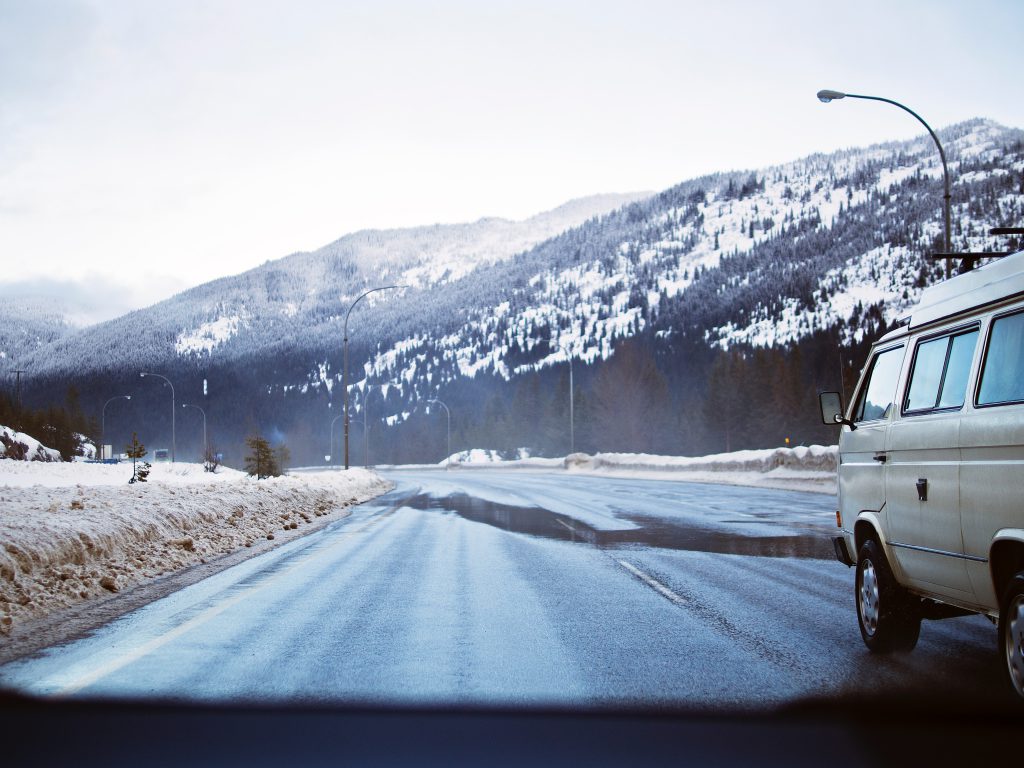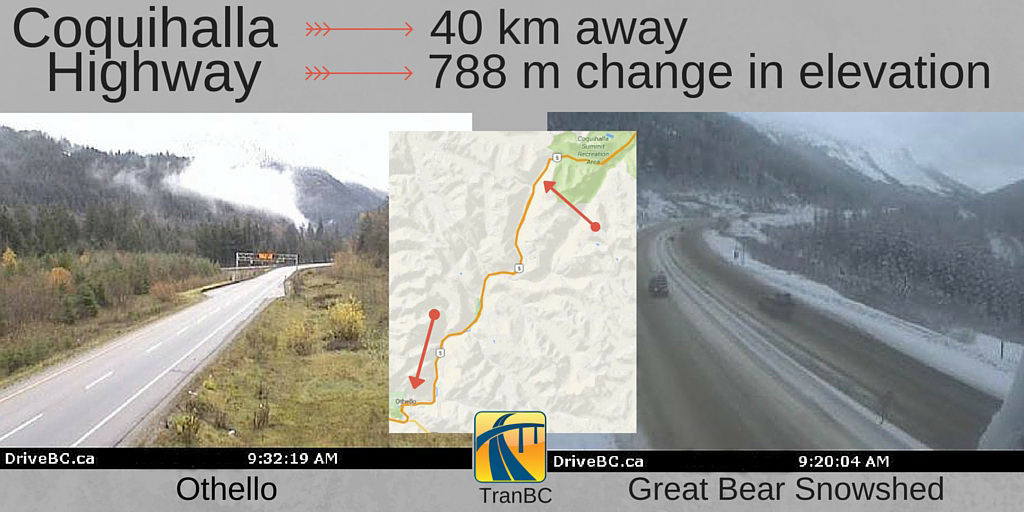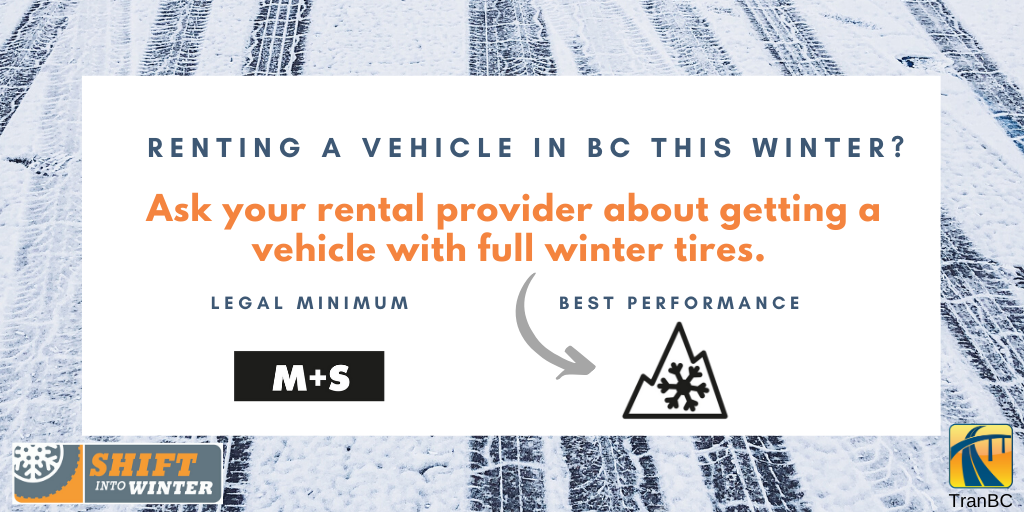
From world-class skiing to west coast storm watching, there are many reasons for visiting BC in winter.
So it’s no surprise folks from out-of-province ask us questions like, “We’re from Alberta – do BC winter driving tire and chain regulations apply to us?”
Short answer: yes! Simple as that, right?
Well, yes, but we also thought it a good idea to compile some more information that would be useful to people who may not be familiar with what winter looks like in BC.
Let’s start by fleshing out that winter tire and chain question, shall we?
Winter Tires & Chains 101 for BC Beginners
All passenger vehicles and commercial vehicles travelling BC highways that are signed as winter tire/chain routes must abide by our winter tire and chain requirements.
Here’s a refresher on what are considered legally acceptable winter tires and chains (note: tire classifications are consistent in North America, so look for the same identifying symbols on the tire sidewall, discussed in the “Passenger Vehicle” link below):
>> Passenger Vehicle – Tire and Chain Requirements
>> Commercial Vehicle – Tire and Chain Requirements
Winter Weather is… Different Here
Winter takes on many forms in BC. Generally, the Greater Vancouver and southern Vancouver Island areas see more rain than snow, along with milder temperatures than the rest of the province. Yeah, south coasters live in a bit of a bubble that way, with a few exceptions. These winter tire and chain route maps show what we mean by that.
And then there are the high elevation mountain passes – more than 50 of them, actually – where severe winter conditions strike hardest and, sometimes, without much warning. For example, you can be enjoying a mild, sunny cruise heading east from Vancouver, and enter a blizzard by the time you reach the Coquihalla.

Known as The Coq, this popular highway is one of three Variable Speed Limit System corridors, which adjust digital speed limit signs based on road and weather conditions.
Environment Canada offers a BC Traveller’s Routes forecast for high elevation highways. Really good link to bookmark.
Renting a vehicle?
Your rental vehicle needs will depend a lot on what part of the province you are visiting. Your average rental vehicle will be equipped with M+S (mud and snow) all-season tires, which meet the minimum legal requirement for winter tire routes. So, if you plan on staying within the Greater Vancouver or southern Vancouver Island areas, and the forecast is classic “wet coast” rain, you may wish to leave it at that.
However, if you plan on travelling the rest of BC, we strongly recommend asking your vehicle rental provider about getting a vehicle with full winter tires, which are identified by the 3-peaked mountain and snowflake emblem on the sidewall. Rental companies in BC offer vehicles with full winter tires for an additional fee.
While you’re at it, may as well ask your rental company about their policy on tire chains. Although rental companies don’t tend to include chains in their vehicles, they can be OK with customers using their own chains, or other acceptable traction device, if properly installed. Definitely something to consider if visiting tourist destinations such as Mount Washington, which has a mandatory chain requirement on its access road during severe winter conditions.

Know Before You Go!
Did you know you can scope out weather and road conditions before even stepping foot… er… rolling tire… in BC? There are more than 450 highway webcams strategically located throughout our highway network, allowing travellers to preview their routes by visiting the DriveBC Traveller Information System website. Here, you’ll also find information about weather, road conditions, incidents, planned events impacting traffic, and more.
Bonus BC Winter Travel Intelligence
Rest Areas: Most of the approximately 170 provincial rest areas are open year-round, but some are only open seasonally. You can preview details about the rest areas along your route by exploring the BC Rest Areas map.
Inland Ferries: BC’s 14 inland ferries are free-of-charge; however, some ferry schedules vary in the winter. Be sure to check the current schedules if you plan on using these crossings.
Time Zones: While most of BC is in the Pacific Time Zone, parts of eastern BC use Mountain Time, which is one hour ahead. This is good to be aware of, especially if you’ve got a specific travel agenda that crosses time zones. There’s never a good time to be rushing on the roads, and winter is the worst of them. See this list of BC cities and their time zones.
Whether business or pleasure – got a trip to BC planned this winter? Welcome!
Are rental car companies legally required to have M&S tires as a minimum during Oct-April winter months for Vancouver area?
Hi Winnie,
Most rental vehicles will be equipped with M+S tires, which meet the minimum winter tire requirement.
If you are renting a vehicle and travelling outside the Greater Vancouver or Greater Victoria areas, it’s a good idea to ensure your vehicle rental is equipped with winter tires. While M+S tires are legally acceptable, tires with the 3-peaked mountain/snowflake symbol provide the best traction in winter conditions. Discuss options with your vehicle rental provider.
Keep in mind, cities, municipalities and private roads (such as ski hills) may have their own bylaws or rules around the use of winter tires, chains or traction devices that may differ from provincial highway regulations. Hope that this information is helpful. More information can be found on our winter driving website: https://www2.gov.bc.ca/gov/content/transportation/driving-and-cycling/traveller-information/seasonal/winter-driving
Hello, we wanted to drive to from Winnipeg Vancouver mid february and drive back around the third week in April. We know what to expect Winnipeg to Calgary, but how about the roads and conditions Calgary to Vancouver, especially through the moutains and fraser canyon? We plan on staying on Hwy #1. Thank you.
Hi there Barry – thanks for your message. Winter conditions (possibly extreme) should be expected when travelling BC highway 1 in February (and even in April). Weather can change quickly in high mountain passes and you should have winter rated tires on your vehicle and carry chains in case you need them. Making sure you have food, water, warm clothes and gloves is also a great idea for travelling BC during the winter. Our traveller information system, DriveBC.ca, will provide you with up to the minute information on incidents and closures impacting our highways and we encourage you to check it whenever possible on your travels. We hope that this is helpful. Safe travels.
I planning to drive to Armstrong BC From Nova Scotia and will get there around the 28 April. Last year I had my all Season Tires and never thought anything of it and we went from Canmore than the Icefield highway and Jasper etc.
After reading about Winter tire law in BC, should I have my Winter tire on to drive across Canada to get to BC on the 28 April or so.
Thanks
Normand
Hi there Normand,
Thanks for your question. If your all season tires are labelled as M+S and have at least 3.5 mm tread depth, they meet the minimum requirement for winter tires in BC. Here’s a link to more info, including which routes require winter tires until April 30 in BC: https://www2.gov.bc.ca/gov/content/transportation/driving-and-cycling/traveller-information/seasonal/winter-driving/winter-tire-and-chain-up-routes
We hope that this is helpful – safe travels!
Hi
I am driving first time during winter from Calgary to Vancouver Trans Canada hwy1(done couple of times during summer). If I have new winter tires (not all season) installed on Sienna Van:
1) do I still need chains?
2) while driving in Vancouver and Surrey do I need to remove Winter tires or I should drive using those?
3) Generally speaking, Is it safe overall to drive with family on this route (Calgary to Vancouver) during Jan? Hoping that roads are not deserted and there is traffic overall 🙂
Hi Akbr. Thanks for checking in with us.
1) You are not required to carry chains in a passenger vehicle, but they can be provide added traction if you hit severe weather. Not a bad idea to carry them in your vehicle, just in case. We suggest using winter tires with the mountain/snowflake logo on the sidewall – sounds like you already have these. More info: https://www2.gov.bc.ca/gov/content/transportation/driving-and-cycling/traveller-information/seasonal/winter-driving/about-winter-tires
2) No, there’s no need to remove your winter tires once you arrive in Vancouver/Surrey.
3) Yes, it is safe to travel this popular route. Please check DriveBC.ca for road conditions/weather information before heading out.
Safe travels!
I have much trouble trying to figure out the road conditions on the web cams.
I really like the Alberta 511 road conditions with the coloured lines for the different conditions for visual ease. Also, knowing if maintenance vehicles are out helps as well for winter conditions.
Hi Anonymous – thanks for your comments – we have shared with our DriveBC web development team for feedback.